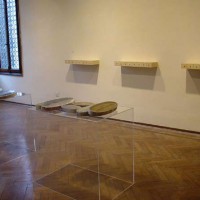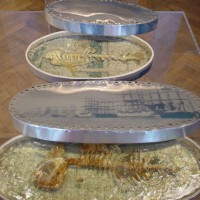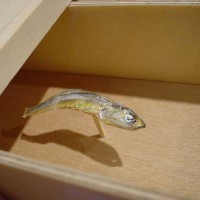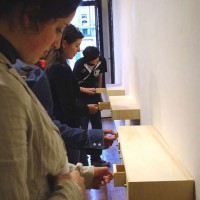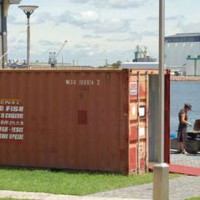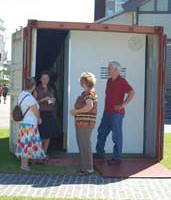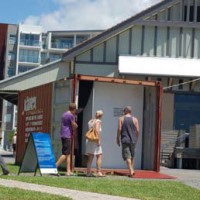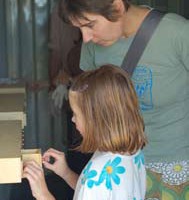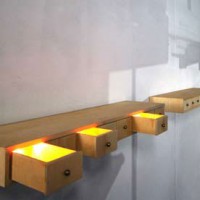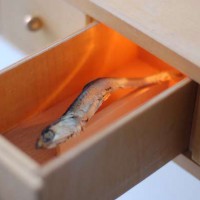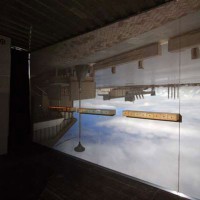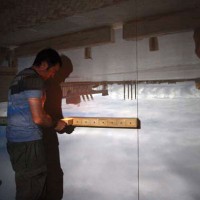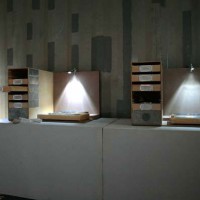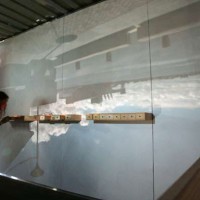Preserved Fish
Materials:
Dried fish, Fish bones, resin, reclaimed aluminium printing press plates, sound scapes, timber, acrylic ink, lights and video.
Concept:
Tricia Flanagan and Ayumi Matsuzaka are tracking stories, visiting ethnographic groups, experiencing cultures, collecting and editing what they find. They travel to different harbours and fishing communities around the globe, and talk with local fishermen and seamen. They cook and eat fish with them, collect bones, stories and recipes as traces of their encounters.
This collection of visual, aesthetic and sculptural objects creates an archive, which forms the basis of an innovative, interactive installation that relates to the context of the exhibition location. The artists preserve the fish bones and display them in made-tomeasure tins, the objects created evidence the collective memory of the site. ‘Memories of past use and its wider global network of experience, revealed the things that sustain communities, those grass root histories that are part of personal and oral traditions rather than official stories.’25
Two boxes travelled to Venice; one from Newcastle, Australia and one from Weimar, Germany. During the Venice exhibition a third box was in progress collecting Venetian stories. Venice is an international port for shipping and luxury liners. Venetian culture is moulded by its unique topography, dominated by water, transport is by foot or gondola along the canals. The sound of Venice is unique – busy with human sounds but with an absence of motor vehicles. The intimate relationship with water is evident in the commercial fishing industry and largely seafood based diet. In addition to the Novocastrian and German fish boxes, twenty-four small dried fish from Japan were displayed in three elongated boxes that resembled tiny specimen draws.
The theme of the exhibition in Venice was an exploration of Export Heimat where sixteen artists, Polish, Japanese and Australian explored the connection between place and identity. For Flanagan and Matsuzaka, a common link between them and the location was that both artists, in their homelands live in harbour side communities, Newcastle and Nagasaki respectively and the exhibition was at another harbour location, Venice.
The two artists met in Weimar, Germany where Flanagan had been working with the artists collective Ag Tiefseh for some years on exhibitions based on variations of the theme, water. For example Täglich Meer 2001 (a word play on ‘Täglich Meer’ taken to mean both ‘more each day’ and ‘the everday ocean’); VI Mare – Weimar Lag am Meer 2002, (Weimar by the Sea); Weimar Schwimmt 2003, (Weimar Swims) the latter was located on the banks of the Ilm River – so the artist became aware that fishing playes a part in Weimarian culture, and the quest began to explore the relationship between place and identity through fish.
The project grows in layers as it adaptes to respond to each new location. In 2008 all of the boxes were packed into a large shipping crate, and travelled by sea to Newcastle to become part of the Back to the City project.
The location was on the wharf edge of Newcastle Harbour outside the Maritime Museum. The harbours edge is a site infused with the memories and histories of Novocastrians.
‘Preserved Fish’ was an intervention in public space that attempted to overlay personal stories on the concrete and steel façades of the site. The project engaged people in the public sphere, re-animating the space through dialogical and relational aesthetics. Enhancing the collective memory of the space, one listens to the voices of fishermen – it’s like putting your ear to the ground to listen to the heartbeat of the city.
The artists in collaboration with architect Geoff Whitnall (Newcastle), presented their findings back to the community using innovative artistic design strategies. Infiltrating the urban space by integrating with the site’s history and the contemporary portscape; a shipping container forms the basic structure for the implantation. Inside, live images of the working harbour are projected, overlaying the visitors with the seascape.
Preserved Fish linked with the local institution, The Maritime Museum and their coinciding ‘fishing’ exhibition. The collaboration involved logistic support and the development of educational material for schools.
From micro to macro levels, the harbour’s edge presents multilayered networks of transaction and exchange.
…Sundays fishing on the harbours edge… …Fishermen sailing daily out through the heads before dawn… …Cargo ships on international shipping lanes lined up to enter the port…
International ships have come and gone over decades, so it’s surprising that Newcastle has very little signage in foreign languages. In Preserved Fish the signage is multi-lingual, and the voices can be heard speaking in their native tongue. Short transcripts explain the meaning in English, but the direct experience is multi-lingual.
The estuary of the Hunter River is the basis for Newcastle’s settlement. From its indigenous past, white invasion in 1791 (by Lieutenant John Shortland), through convict settlement (1804 – 1822) to the busy city of today, the Hunter River and Newcastle Harbour has become an international port city.
The former industrial worksites of the wharf were open only to authorised rail and wharf workers and formed a buffer from the harbours edge excluding the public from the waters edge. An earthquake in 1989 and the closure of BHP in 1999 left the city as a post industrial and commercial wasteland.
The public’s gaze gradually turned from the city centre shopping strip, which runs parallel to the river but is divided from it by a rail corridor, toward the harbour.
The valuable land along the foreshore began to be redeveloped into corporate hubs with correspondingly prestigious buildings and luxury apartments for inner city living.
The surrounding spaces now form privately owned public spaces, which are bought into rather than lived in places. These modern architectural spaces have been designed as the new city centre’s cultural precinct linking the Museum, Theatre, Art Gallery, Library and Sporting Facilities; the new heart of the city.
The site-specific urban installation, ‘Preserved Fish’ recalls a time when the individual proletariat experienced the harbour across weedy fields and industrial wastelands or further back when indigenous communities fished there, and reminds the current inhabitants that this place of new development has a collective memory. It is not just an empty location waiting to come to life through redevelopment. The artwork unites the designer world of the commercial landscape with its roots, its soul – the people who inhabit the place.
Direct engagement with local people in this work is an artistic strategy to create a sense of ownership and pride of place and to develop the urban identity of the city centre. But it is not just a contemporary aural history of Novocastrian stories.
The artists connected the port with other international harbours in China, Japan, Germany and Italy and brought together a cultural collection of multilingual sound sculptures, images and artefacts.
During the Newcastle exhibition of ‘Preserved Fish’ Flanagan and Matsuzaka created a short film featuring Newcastle harbour from the perspective of a canoe, documenting the action of collecting, preserving and eating fish using a traditional Japanese method that Matsusaka learnt from Nagasaki fishermen. Two other video works were screened in the shipping container, both filmed in Hong Kong in The Peoples Republic of China, one featuring the harbour and the other the fish markets.
Artists are often ‘monadic’ – a contemporary nomad that carries his culture with him, ones culture becomes starker when dislocated from its heritage. Across the cultural platforms what is revealed are the commonalities and differences that make a rich ethnographic tapestry, an exchange of cuisine and a love of fishing.
Project partners:
- Ayumi Matsuzaka
- Geoff Whitnall
- Newcastle Maritime Museum
- Ag Tiefseh
Exhibitions:
- ‘Public Art and Alternative Tactics in Post-Acquisitive Society – Urban Part 2’ Palmer Street Gallery, Darlinghurst, Australia. January 2009
- Back to the City, Newcastle Australia, Lee Wharf boardwalk, outside the Newcastle Maritime Museum, Newcastle, Australia. January 2008
- Ag Tiefseh – Export Heimat, Fondazione Bevilacqua La masa, Palazzetto Tito,Venice, April – May 2005.
Publications:
- LEHMANN, S. (Ed.) (2008) Back to the City – A Dialogue between Artists and Architects, Newcastle, Australia, Hatje Cantz Publishers. Pp. 5, 29, 42, 47, 143, 146 – 7, 152, 166.
- WILLIAMS, K. (2008) Plateful of Piscatorial Pleasures. The Herald. 16th Feb ed. Newcastle. P. 16.
- LEHMANN, S. (2008) Artists and Architects Redefine the Cityscape. The Herald. 19 Jan ed. Newcastle. P. 10.
- BLAXLAND, M. (2007) Steel City Prepares to Show off its Creative Side. The Sun Herald. 18 Nov. ed. Newcastle. P. 4 – 5.
- FLANAGAN, T. (2005) Preserved Fish. IN RUFFERT, F. (Ed.) Ag Tiefseh – Export Heimat. Weimar, Fondazione Bevilacqua La Masa. Pp. 3, 34 – 35, 62.
Thanks:
Funding support by the Fondazione Bevilacqua La Masa, The Bauhaus University, the State of Thuringia and the City of Weimar, Back to the City – Newcastle, The University of Newcastle. Christian (Ayumis) Jens Gunter, Megan Lewis, Angela Vettese, Marco Ferraris and Stefano Coletto, Prof. Marco de Michelis and Prof. Liz Bachhuber.
Endnotes:
25. PHILP, A. (2009) Lost in Space. IN LEHMANN, S. (Ed.) Back to the city : strategies for informal urban interventions. Ostfildern, Germany, Hatje Cantz Verlag. P. 42 – 3.
